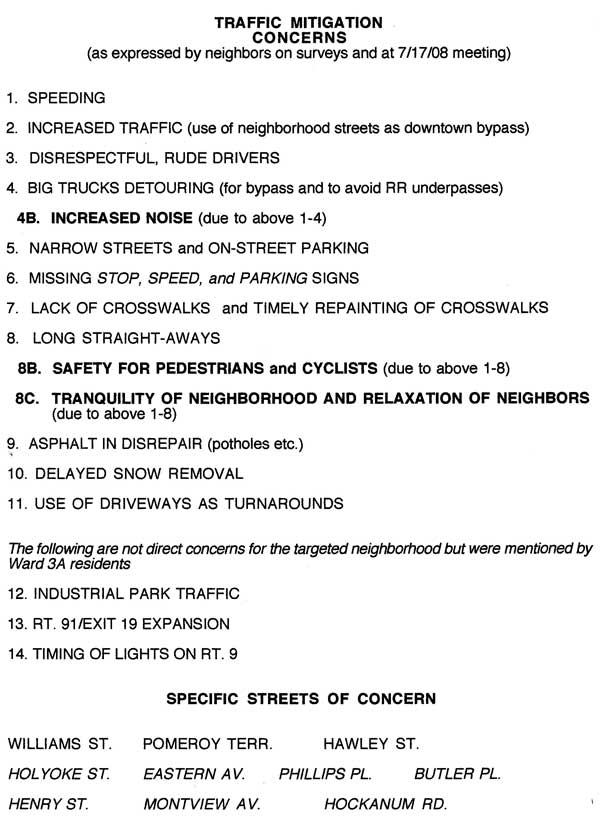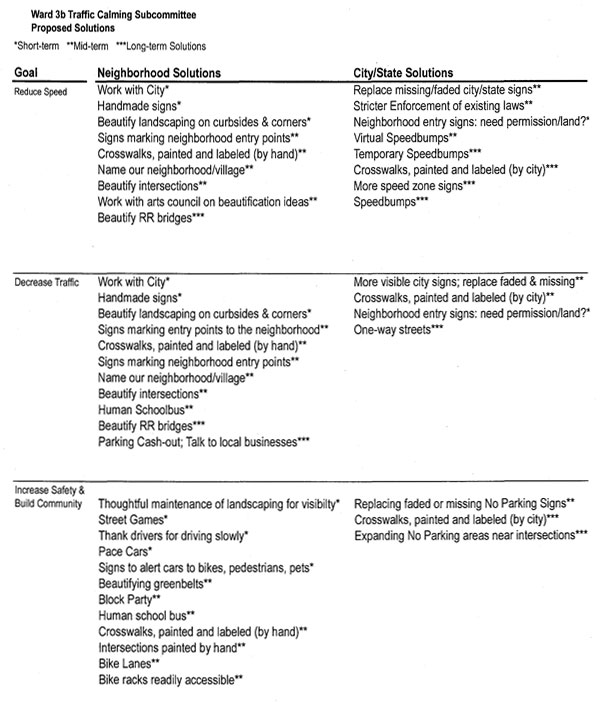The Ward 3 Neighborhood Association is circulating the following announcement from the Department of Public Works:
On behalf of the Northampton DPW, I am pleased to invite you to “A Traffic Calming Informational Discussion” scheduled for
February 26th, 2009 (Thursday @ 7:00 pm) in the JFK Middle School Community Room located at 100 Bridge Road.The public is ENCOURAGED to attend this event.
We will be discussing the pros and cons of placing speed humps within Northampton Streets. There will be short presentations from
Emergency Response Personnel (fire, ambulance and police), Transportation personnel, and the Safe Routes to School (SRTS)
Assessment Team for the Jackson Street School.If you are a presenter, please contact me with your technological requirements for the discussion. There is a projector and screen
available for laptop hookups but there is not an internet connection.Please invite a friend, and let me know if you can attend.
Call me with any questions.
Hope to see you there, Laura
—
Laura Hanson, Asst. Civil Engineer
Dept.of Public Works, Engineering Division
125 Locust Street, Northampton, MA 01060
Phone: (413) 587-1570, ex. 112
lh*****@ha*****.org, Fax: (413) 587-1576
See also:
City Council Takes Up Traffic Calming Manual on 9/18/08; Traffic Concerns from Ward 3; Impact of Traffic Calming on Bicyclists and Snow Removal
Here are traffic concerns (PDF) collected by members of the Ward 3 Neighborhood Association over the summer, along with proposed solutions (PDF):


Based on a cursory search of the web, it appears that different
traffic calming techniques can have dramatically different impacts on
bicyclists and snow removal…
Selected Comments on The (Traffic) Calming Chicane at TreeHugger:
…Fine when they are properly signposted – however when they use
non-illuminated bollards with faulty reflectors they can be death traps
at night…I
am currently in my second apartment, with a traffic calming device in
front of it. Both are tiny round abouts. We often hear the screeching
of breaks, especially on Friday and Saturday nights, followed by
thumps, as cars don’t see the badly illuminated round about, and run
into it……this [chicanes] usually trims the amount of
available lane for cyclists. This means that cyclists have to
permanently merge with car traffic to traverse the road that has the
chicanes…In Atlanta, it’s illegal to ride on the sidewalk.
The traffic calming is so miserable that a local bike advocacy group is
constantly fighting it…Narrower traffic lanes, wider
sidewalks? Ok, but if you live where there is snow you’ll need the
extra width to put the snow somewhere.. up on the sidewalk I guess. You
also effectively block the entire road should their be a breakdown…Diverters
– These do work, we have some in Minneapolis, but they are basicaly
long chicanes which can cause a total mess by blocking in traffic when
things go wrong. May seem trivial to some, but try backing up a school
bus in the winter for three winding blocks on a dark winter night
because the road is blocked with a stalled car.Bumps, Humps,
Strips, Cushions, et al… become ice ramps, road debris, snow plow
driver injuries, pot holes, and other such wonderful things after a
couple years in a winter state. Nothing funnier than watching people
stuck on a road full of speed bumps because the ice won’t let them get
enough traction and they can’t get a run up on the bump…I
like what Sacramento and Berkeley do instead, where they have bicycle
boulevards and streets with lots of undulations (like speed bumps but
gentler on a cyclist) to keep traffic slow thru residential areas……usually [in Holland] there is a bypass for cyclists, so they do not have to go through to the chicane…
This
was tried in Concord NH. First millions was spent on speed bumps then
millions on speed tables (long drawn out speed bumps); the best
solution by the way, because of bikers & snow removal. Then
millions was spent on these stupid “chicanes”. DEATH TRAPS actually!!!!
Nightmare because traffic is actually one lane, only one car can go
through at a time. How do you enforce right of way? …Snow removal was
a nightmare. One year later millions was spent on making the streets as
they had been since the beginning of roads…. STUPID!!!! STUPID!!!!
STUPID!!!
Traffic Logix (a commercial vendor)
For
cities in the snow belt, the winter months can prevent installing
traffic calming devices due to interference with snow plows. It can be
difficult to plow snow over speed humps or cushions, and solutions can
be dug up or destroyed by the plows. Traffic Logix offers a simple
solution to this problem. All of our devices are simple to install and
can be easily removed each winter and reinstalled in the spring. Our
devices have been installed in cities across the Northeast where they
are removed each year during the winter months. In cities that use
asphalt solutions, snow plow damage often causes cities to have to
recreate the devices each spring. This is a timely and costly process.
The removable Traffic Logix solutions are a far more cost-effective and
convenient solution. [See videos of experiments in Northampton with Traffic Logix devices.]
bicyclinginfo.org: Traffic Calming
Some bicyclists are concerned that the traditional techniques used to slow traffic down have a negative impact on them:
- Street
narrowings that tend to slow motorists can mean that motorists drive
closer to bicyclists when passing them or try to “beat” the cyclist to
the narrower section of the road.- Speed humps and other devices
that change the level of the roadway may be uncomfortable and
inconvenient for bicyclists. Another problem with speed humps is that
drivers may try to swerve around the edges to avoid the full impact of
the hump, which encourages them to swerve into where the bicyclist is
riding along the curb. This is a real problem with speed humps and
bicycles.In the ITE report Traffic Calming: State of the Practice, author Reid Ewing quotes from Boulder, Colorado bicyclists who opposed some traffic calming projects for these reasons.
Throughout
the rest of Europe, however, there has been widespread acceptance that
traffic calming can benefit bicyclists. Clarke and Dornfeld (FHWA,
1994) concluded in a report written as part of the National Bicycling
and Walking Study that “the experience from Europe clearly shows that
bicycle use has been encouraged by traffic calming”.
- Well
designed and implemented traffic calming measures can have a number of
beneficial impacts for bicyclists and pedestrians. The reduced vehicle
speeds associated with such projects can reduce both the severity and
incidence of motor vehicle/ bicycle crashes and can make bicyclists
feel more comfortable in traffic.- In certain situations,
traffic calming techniques may be used to reduce the number of motor
vehicles traveling along particular streets, and can increase the
number of bicyclists.- Traffic calming techniques can be used
to provide better roadway conditions for bicyclists by better defining
the space available to each mode, by improving intersection design for
nonmotorized users and by giving greater priority to their movement.